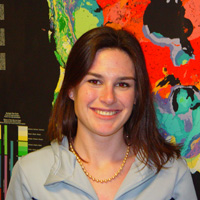 Miocene volcanic rocks and conglomerates, SE California: Evidence for Neogene reactivation of the Chocolate Mountains anticlinoriumMelanie Biggs Monday, May 9th, 2008 |
||
|
||
| ABSTRACT In and around Picacho State Recreation Area, early Miocene volcanic rocks are folded about the Paleogene Chocolate Mountains anticlinorium. New laser ablation U-Pb zircon geochronology reveals that the Walker andesite, one of the youngest mapped volcanic units lying on the northern limb of the anticlinorium, is 23.5 ± 1.0 m.y. old. The early Miocene volcanics, including the 23.2 ± 0.2 Ma ignimbrite of Ferguson Wash, also are displaced in a dextral sense ~1 km by the Taylor Lake fault system. About 11-13 km west of Picacho, flat-lying gravels of the upper member of the Bear Canyon conglomerate are capped by the ~13 – 9 Ma basalt of Black Mountain. In contrast, the lower and upper members of the Bear Canyon conglomerate at Picacho are tilted ~21o and ~15o respectively on the northern limb of the anticlinorium, while flat lying gravels of the upper member are not folded nor transected by the Taylor Lake fault system. Geochemical data indicate that the clasts in the lower member of the conglomerate were derived from the progressive unroofing of the underlying early Miocene volcanics. These observations suggest that the Chocolate Mountains anticlinorium is a long-lived feature that may have been reactivated during formation of the Taylor Lake fault system sometime between ~23 Ma and ~13-9 Ma. If this interpretation is correct, then the Chocolate Mountains anticlinorium and associated structures would have accommodated some Neogene displacement, and, as a result, the discrepancy between paleoseismic and plate tectonic estimates of the displacement history between the Pacific and North American plates would be mitigated to some extent. |

